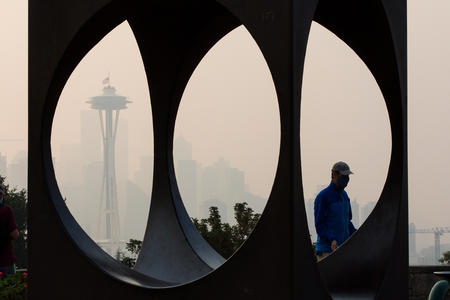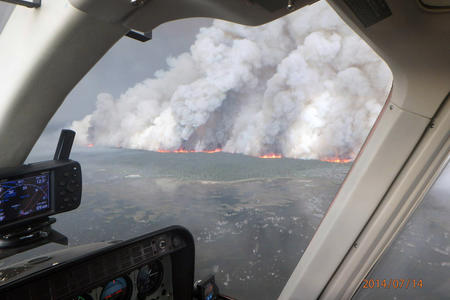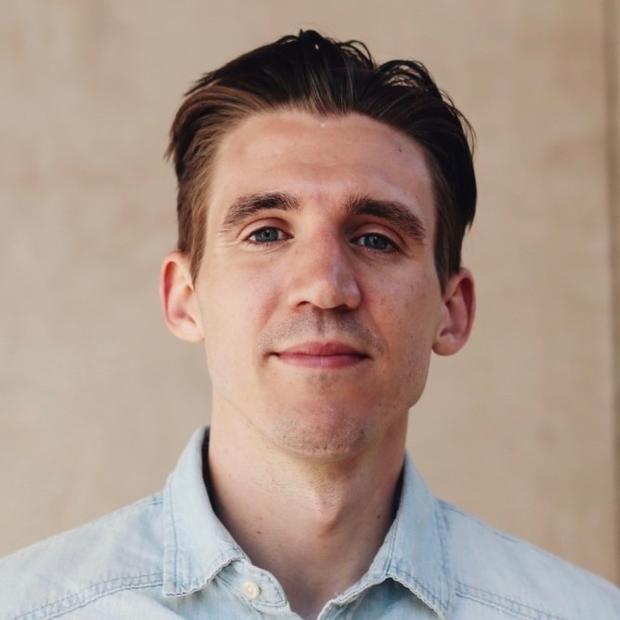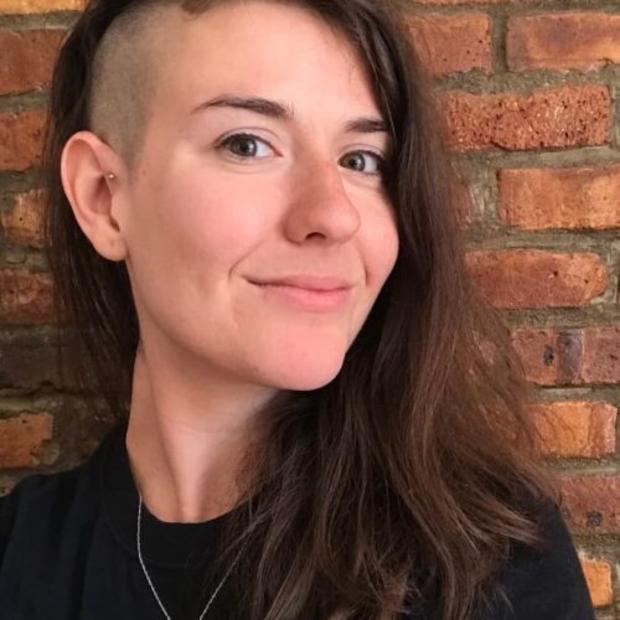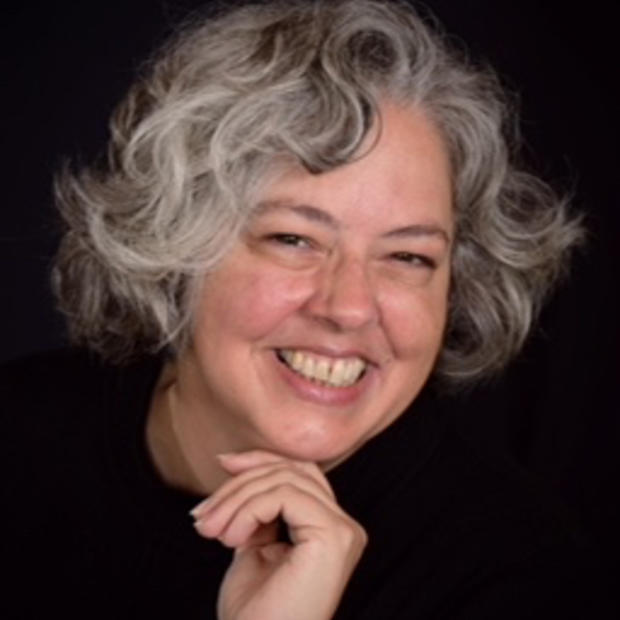Worse, the following year Culp evacuated her home and stayed away for several days as a wildfire grew closer to the edge of her Okanogan County town before stopping short of her place by a mere two blocks. Her home was spared. Some friends lost theirs in that Twisp River fire, which merged with others to become what is now the largest wildfire in state history, the Okanogan Complex fire. Three firefighters, including one Culp knew, died.
“Every summer it feels like our community is on edge, wondering if it’s going to be a bad fire season,” said Culp, who spent weeks indoors to avoid heavy smoke during the extreme wildfires. “I feel like it’s kind of gotten to this point where most people around here sort of have this low level of anxiety every time they smell smoke. We hear sirens, and [it’s] like, ‘What is it?’ ”
For her part, “I don’t actively worry about it, but feel vigilant.”
“It just feels more like this unfortunate reality that we all have to live with,” Culp said. “I expect drought and megafires to get worse as climate change intensifies, and that is scary.”
The Methow Valley isn’t unique. Disasters, including fires, hurricanes and flooding, are intensifying as climate change accelerates. Already, the U.S. has faced nearly 40 such events costing at least a billion dollars each in the past decade, more than during any previously recorded period. Washington state in the past decade has been affected by five wildfires and three drought disasters costing at least a billion dollars apiece.
Ask us questions about your health and wildfire smoke at the bottom of this story, or click here.
Studies, meanwhile, show symptoms of anxiety, depression or post-traumatic stress following these disasters. And mental health experts worry the psychological costs from these increasingly common cataclysms — with a pandemic now overlaid on top — could be unprecedented as well.
The nation isn’t ready.
The country’s primary aid for mental health after disasters is the Crisis Counseling Assistance and Training Program, run by the Federal Emergency Management Agency and the Substance Abuse and Mental Health Services Administration. Every year, the program distributes an average of $24 million, or 1% of FEMA’s annual relief fund, to send mental health workers into disaster-stricken communities and provide other support. But the Center for Public Integrity and Columbia Journalism Investigations found that this help usually lasts about a year, even though the psychological effects can linger for many more and reaches only a fraction of survivors.
After Hurricane Maria struck Puerto Rico in 2017, for instance, 18% of the island received counseling paid for by the program, even though many more were affected. In Houston, where Hurricane Harvey’s flooding was widespread, less than 1% of residents saw counseling in the 2017 disaster.
This story was published in partnership with the Center for Public Integrity and Columbia Journalism Investigations.
The FEMA-funded program has given out $867 million nationwide in its more than three decades of existence — just slightly more than the money one Defense Department agency lost track of in a single year.
Studies show other forms of federal assistance, like housing aid, are distributed unevenly, exacerbating inequalities and drawing out recovery for communities of color and people with less money. This, in turn, compounds the trauma and emotional burdens of a disaster.
The Substance Abuse and Mental Health Services Administration referred questions to FEMA, which funds the effort. FEMA said its program, often shortened to CCP, provided counseling to 1.4 million people in the past five years and gave brief help to several million more.
“The toll that disasters put on mental health is well documented and part of the reason FEMA funds the CCP,” a spokesperson wrote in an email. The program, however, “exists to supplement, not supplant, state, local, tribal and/or territorial resources.”
In Washington state, almost no wildfires qualify for such federal dollars to help survivors. That’s because states are eligible to apply for the agency’s counseling grants only after a presidentially declared major disaster. The wildfire-prone Evergreen State has had only three major disaster declarations for fires, and Culp and fellow residents of the Methow Valley weathered two of them.
And even though those 2014 and 2015 fires stand out as the largest in state history, the affected areas still didn’t receive the full range of help the federal government makes available after major disasters.
The lack of federal resources offered to places in Washington state devastated by fires — no individual assistance, no crisis counseling — propelled local nonprofit leaders and elected officials in the Methow Valley to fill the gap and do the work themselves.
InvestigateWest is a Seattle-based nonprofit newsroom producing journalism for the common good. Learn more and sign up to receive alerts about future stories here.
The lack of federal aid leaves more Americans affected by climate-driven disasters every year, with serious emotional consequences. Even with FEMA aid, state and local resources aren’t enough.
Public Integrity, Columbia Journalism Investigations and newsrooms across the country, including InvestigateWest, asked people affected by wildfires, hurricanes and floods — and the professionals helping such survivors — to share their experiences. More than 230 responded to the online survey, most from regions repeatedly hit by disasters in the past decade. That ranged from Puerto Rico, struck by seven major storms, to some Northern California communities fighting wildfires every year.
Among Washingtonians surveyed, the 2014 and 2015 wildfires loomed large. Case in point: Seven days after Benjamin Drummond and Sara Joy Steele brought their newborn home from the hospital in July 2014, smoky skies forced them to face a decision. Should they leave to protect their son’s tiny lungs, or stay?
As they finished packing for a three-hour drive to Seattle, clouds of dark smoke billowed over their 800-square-foot Twisp home.
“It was clear that leaving was the right decision,” Benjamin wrote on the couple's website about the fire that would race to the Columbia River within 30 hours and become known as the Carlton Complex fire. He returned to his home the next day to try to defend it with help from others, shooting cellphone photos as a DC-10 dropped a line of fire retardant along his eastern property line. In the end, his house stayed intact. His barn burned down.
Drummond today remains very concerned about the possibility of experiencing more wildfires in his community. He doesn’t feel significant negative experiences from the fire that devoured his barn, however, and remains philosophical about smoky skies, with the exception of September 2020’s interminable smoke socking in the entire West Coast. “We had a local fire; it was a local issue. And you could get in your car and drive for three hours and be out of it,” he said of the 2014 fire. “This,” he said of the 2020 smoke event, “is different.”
A small amount of help
FEMA’s crisis counseling program was made for disaster survivors who want help. But some say they never got it.
Established in the 1980s as a short-term disaster relief grant, the program funds free emotional help for anyone affected by a major disaster. It’s been used in every state, plus Puerto Rico and other territories, for more than 400 traumatic events in all.
States with some of the most damaging climate-related catastrophes in the past decade said they rely largely — often entirely — on the program’s funding to support disaster survivors’ mental health. That typically includes state hotlines and crisis counselors who, until the pandemic hit, would go into communities and offer help in person, sometimes door to door. After floods and hurricanes in South Carolina, for instance, counselors showed up to town halls, local meetings, even Christmas parades.
States are required to plan for the mental health consequences of disasters. Officials said they’re grateful when they get CCP funding and appreciate the flexibility to plan the response they think will suit their communities best. But the way the program works can also impede efforts to help.
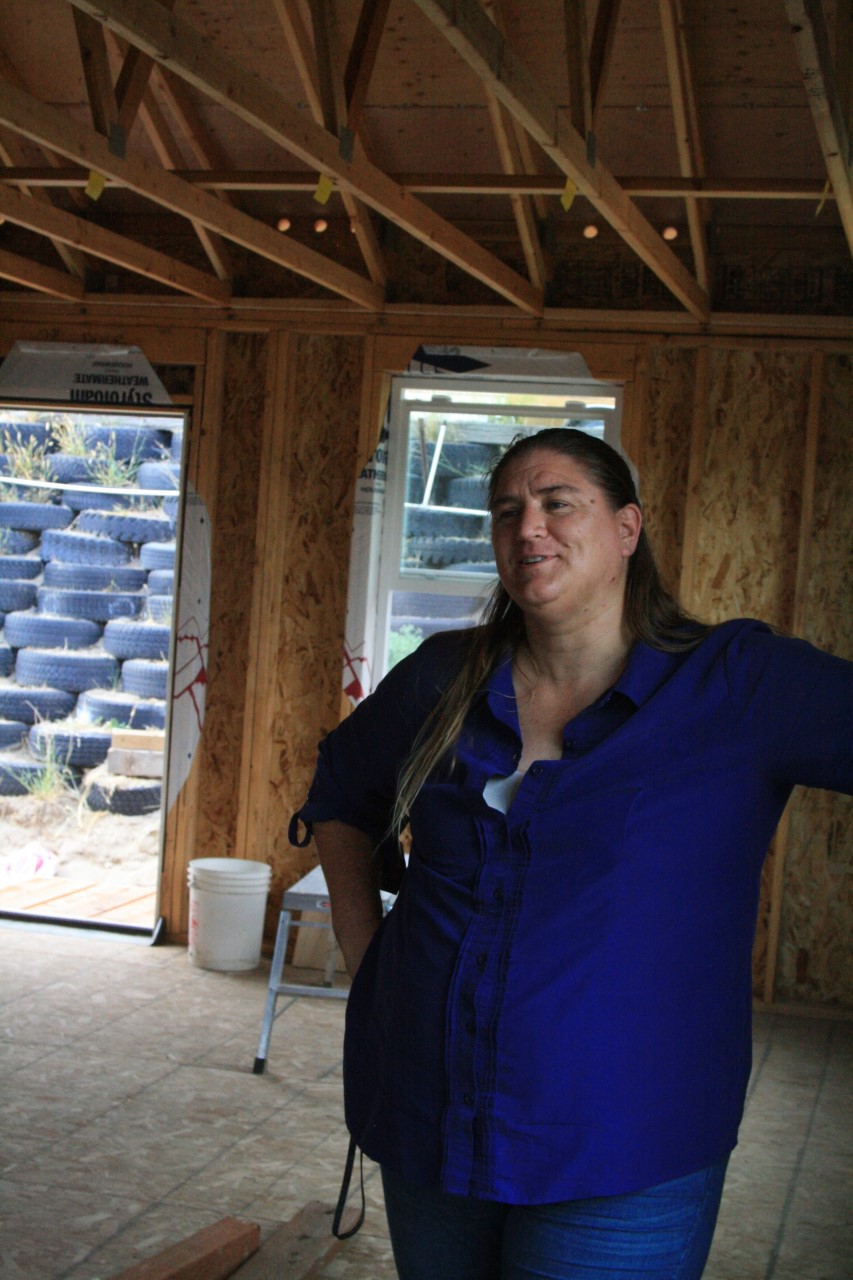
Wildfires often aren’t deemed large enough to qualify for a federal emergency declaration and the support that such a declarati“on makes available. A Government Accountability Office report said “wildfire disasters are generally a small proportion of the major disaster declarations FEMA supports,” but notes that climate change may boost future demand for the agency’s help.
When events do pass the unspoken threshold, states must complete long applications justifying the need. Iowa’s most recent request, for instance, ran 168 pages. And states must fill out two applications if they want to access the full program because FEMA splits it into “immediate” and “regular” phases. The second application can take months to be approved.
The agency’s reasoning is that states should receive assistance only if the event would overwhelm existing mental health services. But that’s almost always the case for major disasters, said Karen Hyatt, emergency mental health specialist with the Iowa Department of Human Services.
“Even when … other FEMA programs are up and running, crisis counseling program administrators are still writing the grant,” she said.
In wildfire-prone California, where counties provide much of the mental health response to disasters, local officials have found the federal program difficult to manage in part because they were on the hook to pay upfront. “It took a long time for them to get reimbursed,” said Michelle Doty Cabrera, executive director of the County Behavioral Health Directors Association of California.
Then there’s the problem of how long funding lasts. The program typically ends after a year, even though studies show that emotional burdens can persist far longer.
“When you’re talking about mental health, recovery takes years,” said Dr. Karen G. Martínez, director of the University of Puerto Rico’s Center for the Study and Treatment of Fear and Anxiety. “Disaster programs don’t really address that.”
Of the nearly 200 survivors who responded to the survey by Public Integrity, Columbia Journalism Investigations, InvestigateWest and other partner newsrooms, a third still reported five or more types of emotional struggles today — at least three years post-disaster in many cases. Meanwhile, 70% of survivors said they didn’t get mental health services after their experience, for reasons ranging from cost to their belief that they didn’t need help. Yet the struggles they linked to the disaster — from anxiety and depression to trouble sleeping — suggest that many could have benefited from the support.
Over 60% of survivors reported five or more types of emotional challenges in the first year after the disaster. Though people across the country participated, the survey isn’t nationally representative, and it may have drawn respondents more affected by disasters than average.
But reports of lingering emotional struggles echo earlier research. Epidemiological studies have found emotional disturbances three years after Superstorm Sandy, which occurred in 2012. One study of low-income mothers affected by Hurricane Katrina in 2005 discovered one in six had post-traumatic symptoms 12 years after the storm.
And the new reality of back-to-back disasters gives people little time to heal, said Amber Twitchell, associate director at On The Move, a social-services organization in California’s Bay Area. Since the Sonoma Complex Fires in October 2017, she said, “We have been in a constant state of disaster response.”
Public Integrity and Columbia Journalsim Investigations reviewed the FEMA crisis counseling program response to six major disasters: floods in Missouri and Iowa; the Camp Fire in California; and Hurricanes Harvey, Maria and Florence in Texas, Puerto Rico and South Carolina, respectively. The program’s reach varied but was small compared with the scale of the disasters, according to federal data obtained through a Freedom of Information Act request.
Puerto Rico’s CCP, which was extended beyond two years to accommodate the high level of need, reached the most people. Of the island’s 3.2 million residents, 580,000 met with counselors for sessions lasting longer than 15 minutes. Yet even there, some areas appear underserved. In Ponce, 35% of residents applied for FEMA financial aid — one indication of how many people were affected — and only 7% received counseling sessions.
Texas has relied on the CCP for 35 disasters, some simultaneously — more than any other state or territory. “Responding to multiple disasters is nothing new for our program and for the state,” said Chance Freeman, director of Disaster Behavioral Health Services at the Texas Health and Human Services Commission.
In many ways — in part because of the repeated poundings — the state has one of the most advanced disaster mental health systems. Yet a review of its Harvey response in Houston shows that even there, the federally funded counseling program reaches relatively few suvivors.
Roughly 22,000 Houston residents received individual, family or group counseling within the 14 months the program was active, according to the Public Integrity and Columbia Journalism Investigations review. At the same time, about 341,000 people there applied for housing or property aid from FEMA.
Freeman said the state used that list of applicants to help identify the hardest-hit areas.
But in the nine Houston ZIP codes with the highest per-capita share of FEMA applicants — all lower-income, majority Black and Hispanic areas — 1% of the population received counseling. That’s about the same level of help provided in some higher-income, majority-white ZIP codes, even though a smaller percentage of residents there applied for aid.
Dr. Annelle Primm, chair of the All Healers Mental Health Alliance, a group that taps volunteers to fill gaps in the government response to disaster-struck communities of color, is not surprised by the data. The unequal distribution of assistance she sees in Black neighborhoods in particular, from food to disaster loans, adds to the emotional toll for residents.
“In this country, the response seems to assume that the people who are affected are middle-class white folks,” Primm said. “They really aren’t thinking about, well, what if the community that is affected was already behind the eight ball, or had preexisting challenges, which the disaster just made … that much worse?”
Presented with Public Integrity and Columbia Journalism Investigations’ findings, a FEMA spokesperson said the program supplements local mental health services, so “there is no universal ideal or adequate level of counseling post-disaster — it varies not only by locality but also by disaster.” The agency added that crisis counseling is available to all U.S. residents through the federal Disaster Distress Helpline.
The Harris Center for Mental Health and IDD (intellectual and developmental disabilities), which ran the CCP in Houston after Harvey, said the findings don’t include other forms of support beyond counseling. The agency led educational sessions with thousands of residents that, it said, could inform and motivate survivors to seek help from other mental health organizations, religious groups, family and friends.
The Texas health department’s Freeman, said the program serves all survivors equally. Among the 16,000 who received individual counseling in Houston, 38% were Black, 30% were Hispanic and 18% were white, according to the counselors’ observations.
“More time would be great and more resources would be great,” he said, but “we’re not there to create a need that doesn’t exist. Communities are resilient.”
Stigma around mental health care and people’s desire to be self-reliant both make it difficult to know when a community no longer needs aid, experts caution. After Katrina, teams dispatched to hard-hit communities found that no one stopped to talk if they set up a table with a “free crisis counseling” sign. “But when we began posting ‘tell us your hurricane story,’ people stopped,” said Danita LeBlanc, manager of Louisiana Spirit, that state’s crisis counseling program.
When Texas reached the end of its Harvey counseling program, 40% of the grant was unspent. Positions were never filled and some staff, including counselors, left before their contract was up. “This is not uncommon, given the temporary nature of the program,” a state health department spokesperson said in an email.
The agency didn’t directly address a question about whether thousands more people could have been counseled with the unused funds. It said it exceeded its goals and got a commendation from the federal government. The money, $5.6 million, went back to FEMA.
The long, uneven road to recovery
How well or quickly someone recovers emotionally from a disaster can depend on how well and quickly they recover in other, more tangible ways.
“It’s not just initial exposure” to a flood or wildfire, said Sarah Lowe, a psychologist and professor at Yale School of Public Health. “It’s more than that: dealing with bureaucracies, finding someplace else to live, financial impacts.”
One example of those traumatic ripple effects: Major disasters worsen homelessness.
In the 2017-2018 school year — marked by Hurricanes Harvey, Irma and Maria — the number of homeless students jumped 57% in districts where a hurricane, flood, coastal storm or wildfire damaged property, according to a Public Integrity and Columbia Journalism Investigations analysis of federal data.
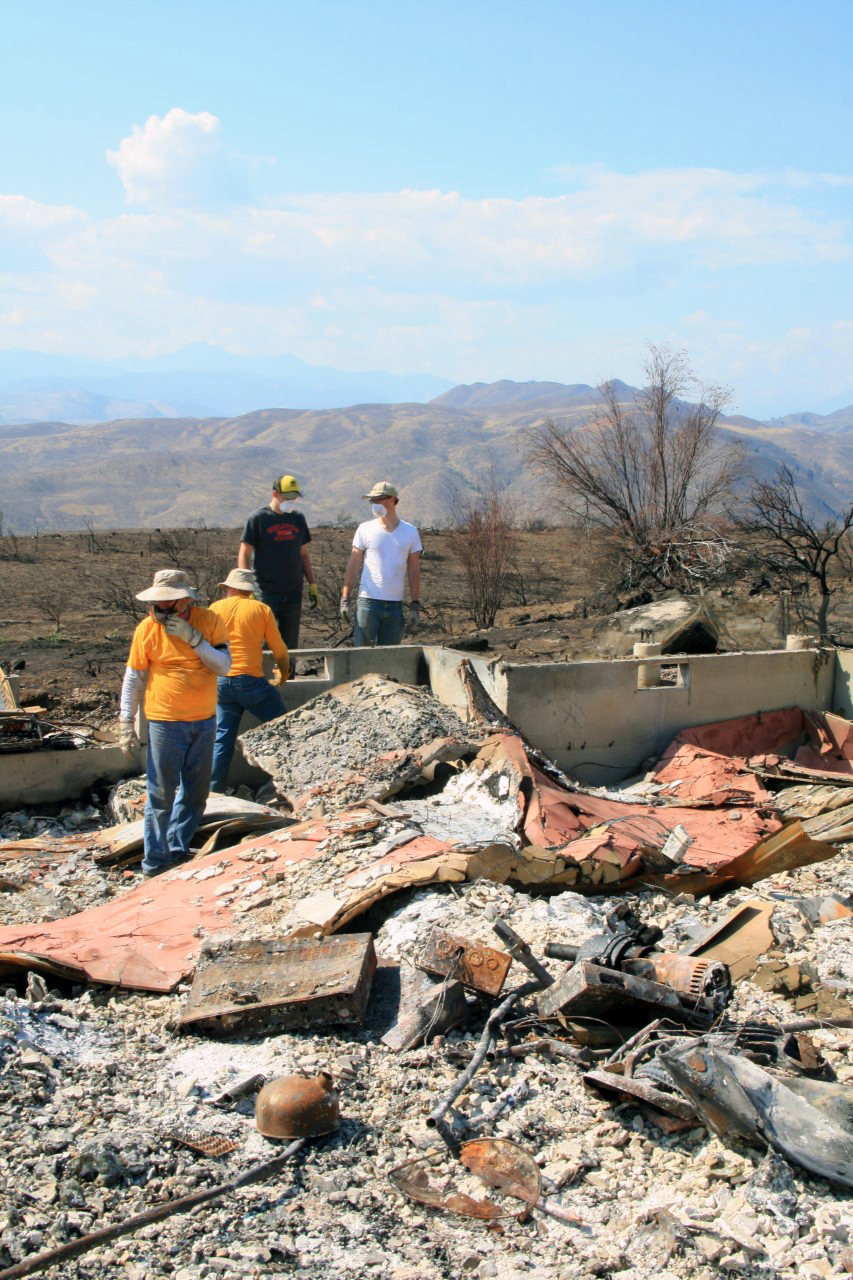
In unscathed school districts that year, student homelessness was virtually unchanged.
The longer the recovery takes, the worse that mental health outcomes can get. This was clear, experts said, from Louisiana after Katrina, where many lived in damaged homes for years and felt forgotten.
Recovery efforts after Harvey were widely applauded by both government officials and emergency management experts. But even in Houston, thousands of low-income homeowners are still seeking aid to repair hurricane damage to their homes, according to the city. Recent analyses show that part of the reason may be the unequal way the federal government distributes aid.
In one study, researchers at the University of Colorado Boulder and the Federal Reserve Bank of St. Louis found that bankruptcy rates in Houston after Harvey rose nearly 30% for flooded low-income households while remaining flat — or even declining — for flooded higher-income households. Emily Gallagher, a finance professor who co-authored the study, attributed that to how those same low-income areas — as well as majority Black and Hispanic neighborhoods — were also less likely to secure federal disaster aid.
In majority-white Houston neighborhoods like Greater Heights, for instance, the rate of approval for FEMA housing aid was 20%. In the Fifth Ward, a majority-Black neighborhood, the rate of approval dropped to 15.5%. This pattern was consistent throughout the city.
“It isn’t because there was less damage in minority areas,” said Gallagher, whose study controlled for that. Her conclusion wasn’t that FEMA is actively discriminating, but that the agency may not be accounting for the way that race in America, after decades of systemic discrimination, is linked “with factors that make it harder to get a grant.”
FEMA’s case workers do their best to help all people struck by disaster, regardless of their background, an agency spokesperson said.
Nationally, other studies have shown differences in aid. Nearly 60% of requests for federal disaster loans were denied from 2001 to 2018, and tens of thousands of other applicants were kicked out of the process before a decision was made, according to a Public Integrity investigation. Ninety percent of denials were attributed to “lack of repayment ability” or “unsatisfactory credit history,” one way that lower-income disaster survivors get shut out of recovery help.
‘Such a betrayal’
Few Americans are protected from disaster-related stress this year. As COVID-19 exacts collective trauma, more than 40 states and territories so far have launched federally funded crisis counseling programs in response.
But the need to stay physically distanced upends the way disaster counseling usually operates. States scrambled to organize video calls and are relying more on hotlines. Unable to send people door to door, they’re hoping that online announcements, posters in stores or pamphlets with food aid will get the word out that help is available. In the midst of all this, some officials are also trying to support the mental health of people who survived extreme weather before the pandemic hit — and they’re bracing for more climate disasters.
“Just being able to reach out ... has been a challenge,” said Garcia Bodley, director of the Louisiana Department of Health’s crisis counseling program. “We’re missing that connectivity we’ve had in the past.”
For the survivors of recent wildfires, hurricanes and floods, the coronavirus represents yet another weight. About three-quarters of those who took the Public Integrity and Columbia Journalism Investigations survey said the pandemic is compounding their previous disaster experience, from piling on more stress to further eroding their finances.
Many of the survey respondents are profoundly anxious about the future. Nearly all were concerned that their community will be hit by more disasters; two-thirds were very concerned. A few had already moved at least in part for that reason.
And they’re deeply frustrated about the government’s preparedness for and response to disaster. Two-thirds rated it “poor.” Only 12% said it was “good” or “great.”
The problems they identified ranged from scant rebuilding help to local development decisions that worsen flooding, a problem so common that the flood-survivor organization Higher Ground now has more than 50 chapters in the U.S. And then there’s the halting, often nonexistent response to the warming climate supercharging storms and fires.
“After a disaster, if the government does not declare a climate emergency and start acting like it, it’s just such a betrayal,” said Margaret Klein Salamon, a psychologist who started the advocacy group The Climate Mobilization after living through Superstorm Sandy. Providing mental health support to survivors even as elected officials fail to rein in global warming “is like a Band-Aid. How can we trust a government that does so little to protect us?”
Even when it’s working well, crisis counseling may be only the start of what survivors need. Counselors try to connect people with longer-lasting services when required — that’s the logic for why the program ends after a year. But America’s fragmented system of mental health care is strapped at the best of times.
Almost a quarter of all U.S. adults with a mental illness reported that they were unable to get the treatment they needed, according to the advocacy group Mental Health America. Some of the most common reasons: lack of insurance, lack of providers, an inability to cover copays.
Asked how the country should change its response to psychological damage in an era of worsening disasters, FEMA said: “There is a need for investment in mental health services at every level, but especially at the local, state, tribal and territorial levels. Survivors will always receive the best, most appropriate services from those who live in their own community.”
‘Climate fires’
As scientists warn that the warming climate will keep adding fuel to extreme storms, Washington serves as a bellwether for what Gov. Jay Inslee calls “climate fires.” The state’s three most destructive fire years hit in the last six years, as 2020 joins the 2014 and 2015 milestones.
“It took five days for 2020 to become our state’s second-worst fire season on record with more than 600,000 acres burned, eclipsed only by the 1.1 million acres burned in 2015,” Inslee wrote in a Sept. 14 open letter to President Donald Trump on the role of climate change in historic wildfires.
Back in the Methow Valley, Rocklynn Culp hopes for a better future. September for her has been Smoke-tember, marked by a family visit watching the Cold Springs fire near Omak, about 40 miles away, from her mother’s house. She checks her phone from time to time to see the latest air quality reading; 150 is unhealthy: “We’ve had over 400 for sure.”
“Now we’re completely socked in. We have horrible air quality,” she said in mid-September from Town Hall in Winthrop, where she works and notices members of the public snap up its free N95 masks available for the taking.
“We’ve got to take climate change seriously,” Culp says. “We’ve got to act or else it’s going to be like this every year — and worse. So, that’s my big thing is that we’ve got to look at the big picture and try and change the trajectory we’re on. Because I mean, I just feel like, personally, it’s like the level of stress that we’re all under … if we face this every year, the level of anxiety is just going to be through the roof.”
Kio Herrera and Chris Zubak-Skees contributed to this article. Dean Russell is a reporting fellow for Columbia Journalism Investigations, an investigative reporting unit at the Columbia Journalism School. Funding for CJI comes from the school’s Investigative Reporting Resource and the Energy Foundation. Jamie Smith Hopkins is a senior reporter and Molly Taft is an intern with the Center for Public Integrity, a nonprofit investigative newsroom in Washington, D.C. Sally Deneen, a Seattle-based independent journalist, provided reporting for InvestigateWest
About this story
The Center for Public Integrity and Columbia Journalism Investigations collaborated on this story with newsrooms around the country: InvestigateWest, California Health Report, Centro de Periodismo Investigativo, City Limits, IowaWatch, The Island Packet, The Lens, The Mendocino Voice, Side Effects Public Media and The State.
We created our survey for disaster survivors and mental health professionals with guidance and vetting from Sarah Lowe, clinical psychologist and assistant professor at Yale School of Public Health; Elana Newman, professor of psychology at the University of Tulsa and research director for the Dart Center for Journalism and Trauma at Columbia University; Gilbert Reyes, clinical psychologist and chair of the American Psychological Association’s trauma psychology division disaster relief committee; and Jonathan Sury, project director for communications and field operations at the National Center for Disaster Preparedness at Columbia University.
No government agency in the United States regularly tracks the psychological outcomes of disasters. And while academic studies may shed light on specific events, the questionnaire was meant to understand experiences from multiple disasters across the country, furthering on-the-ground reporting. It is not a formal, randomized survey. Respondents participated voluntarily and without compensation. For that reason, our results may not represent the general experience of disaster survivors.
In all, 197 survivors and 41 professionals responded from 17 states and Puerto Rico. Our questions focused on climate-related disasters — hurricanes, floods, wildfires — within the last 10 years, as well as COVID-19. We asked about financial, physical, behavioral and emotional outcomes, questions modeled on professional standards for mental health surveys. We did not include a few responses in our findings because they came from people commenting on disasters other than wildfires, hurricanes or floods.
Public Integrity’s Kristine Villanueva led audience engagement on the survey. She and journalists Megan Cattel, Kio Herrera, Molly Taft and Alex Eichenstein assisted with that outreach. Rebekah Ward translated the questionnaire into Spanish. Dean Russell, Kristen Lombardi, Villanueva and Jamie Smith Hopkins developed it, and Hopkins analyzed it.




